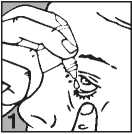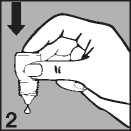Rimexolone 1% Eye Drops
Out of date information, search another000-0000D
VEXOL 1% (10mg/ml) EYE DROPS, SUSPENSION/ RIMEXOLONE 1% EYE DROPS, SUSPENSION (Rimexolone)
Patient Information Leaflet
This product is known by the above name but will be referred to as Vexol throughout this leaflet.
Read all of this leaflet carefully before you start using this medicine
- Keep this leaflet. You may need to read it again.
- If you have any further questions, ask your doctor or your pharmacist.
- This medicine has been prescribed for you. Do not pass it on to others. It may harm them, even if their symptoms are the same as yours.
- If any of the side effects get serious, or if you notice any side effects not listed in this leaflet, please tell your doctor or pharmacist.
In this leaflet
4. Possible side effects
5. How to store Vexol
6. Further information
1. What Vexol is and what it is used for
2. Before you use Vexol
3. How to use Vexol
1. WHAT VEXOL IS AND WHAT IT IS USED FOR
Vexol belongs to a group of medicines known as corticosteroids.
It is used to prevent or treat eye inflammation following surgery of the eye and to treat inflammation of the eye surface and the front portion inside the eye (anterior segment).
It helps to relieve the symptoms of inflammation such as redness, soreness and swelling.
2. BEFORE YOU USE VEXOL Do not use Vexol...
• If you have any type of infection of the eye that is not being treated. Use of steroids may make infections worse.
• If you have a red eye that has not been seen by a doctor.
• If you are allergic to rimexolone or any of the other ingredients listed in section 6.
Ask your doctor for advice.
VEXOL is not for use in CHILDREN.
Take special care...
• If you have a disorder causing a thinning of the eye tissues, such as rheumatoid arthritis,
Fuch's dystrophy or following a corneal transplant. Steroids may cause further thinning and possible perforation.
• Steroids applied to the eye may delay the healing of your eye wound.
You may still be able to use Vexol, but discuss it with your doctor first.
Pregnancy and breast-feeding
If you are pregnant or might get pregnant, or if you are breast-feeding a baby, talk to your doctor before you use Vexol.
Driving and using machines
If your vision is blurred or your sight is affected in any way following the use of Vexol, you should not drive or operate machinery until your vision is clear.
Using other medicines
Tell your doctor or pharmacist if you are taking or have recently taken any other medicines, including medicines obtained without a prescription.
If you are using more than one eye preparation, wait 15 minutes between each application.
Important information if you wear Contact Lenses
Wearing contact lenses is not advisable during treatment of an eye inflammation as it may make your condition worse.
Do not use the drops while wearing contact lenses. Wait at least 15 minutes after use before putting your lenses back in. There is a preservative in Vexol (benzalkonium chloride) that can discolour soft contact lenses and may cause eye irritation.
3. HOW TO USE VEXOL The usual dose
This will depend on the reason for use.
Inflammation (red, painful eye)
Apply 1 drop in the affected eye 4 times a day or more often, if advised by your doctor.
Inflammation of the inside of the eye (Uveitis)
1st week - Apply 1 drop in the affected eye every hour while awake.
2nd week - Apply 1 drop every 2 hours while awake.
3rd week - Apply 1 drop 4 times a day.
4th week - Apply 1 drop twice daily for the first 4 days and then apply 1 drop once daily for the last 3 days. Inflammation after eye surgery
Apply 1 drop in the affected eye 4 times a day, beginning 24 hours after your operation and continuing for the first 2 weeks afterwards.
Not for use in CHILDREN.
Remove the loose collar from the cap when the bottle is first opened.
Always use Vexol exactly as your doctor has told you. You should check with your doctor or pharmacist if you are not sure.
How to use
• Wash your hands before you start.
• Shake the bottle well.
• Twist off the bottle cap.

• Hold the bottle pointing down, between your thumb and fingers.
• Tilt your head back.
• Pull down your lower eyelid with a finger, until there is a 'pocket' between the eyelid and your eye. The drop will go in here (picture 1).
• Bring the bottle tip close to the eye. Do this in front of a mirror if it helps.
• Do not touch your eye or eyelid, surrounding areas or other surfaces with the dropper. It could infect the drops.

• Gently press on the base of the bottle to release one drop at a time (picture 2).
• Do not squeeze the bottle, only a gentle press on the bottom is needed.
• If you use drops in both eyes, repeat the steps for your other eye. Put the bottle cap firmly back on immediately after use.
• If a drop misses your eye, try again.
• If you forget to use Vexol, just use it as soon as possible. However, if it is almost time for your next dose, skip the missed dose and go back to your normal dosing schedule. Do not take a double dose to make up.
• If you use more Vexol than you should, it can be washed out with luke warm water.
• If treatment with Vexol is stopped...
A flare-up of inflammation may occur if treatment is discontinued early. Do not suddenly stop using the product without your doctor's advice. Your doctor may want to gradually reduce the amount you use to reduce the chance of unwanted effects.
If you have any further questions on the use of Vexol, ask your doctor or pharmacist.
4. POSSIBLE SIDE EFFECTS
Like all medicines, Vexol can cause side effects, although not everybody gets them.
• You may experience some or all of the following effects in your eye(s):
Common (affect 1 to 10 people in 100):
Blurred vision, discharge, discomfort, pain, a feeling of something in your eye, increased pressure in the eye. Uncommon (affect 1 to 10 people in 1000):
Redness of the eye or inside the eyelid, itching, dry eyes, swelling, watery eyes, sensitivity to light, irritation, crusting on the eyelids, serious infections, eye surface inflammation, scarring or other disorders.
Rare (1 to 10 users in 10,000):
Swelling of the back of the eye, eyelid swelling.
Not known (cannot be estimated from the available data): Reduced vision.
• You may also experience effects in other areas of your body including:
Uncommon (affect 1 in 10 people in 1000):
Headache, low blood pressure, runny nose, redness or soreness of the throat, bad or unusual taste.
Rare (1 in 10 users in 10,000): Allergy.
Not known (cannot be estimated from the available data): Chest pain.
• If Vexol is used for a long time this can lead to an increase in pressure inside the eye or the formation of cataracts, both of which can lead to decreased vision. It can also lead to infections, as your natural resistance to these is reduced.
Reporting of side effects
If you get any side effects, talk to your doctor, pharmacist or nurse. This includes any possible side effects not listed in this leaflet. You can also report side effects directly via the Yellow Card Scheme at: www.mhra.gov.uk/yellowcard.
By reporting side effects you can help provide more information on the safety of this medicine.
5. HOW TO STORE VEXOL
• Do not use after the expiry date printed on the carton or bottle label. The expiry date refers to the last day of that month.
• Vexol 1% (10mg/ml) eye drops, suspension/ Rimexolone 1% eye drops, suspension should not be stored above 25°C. Do not freeze.
• You should discard any unused suspension 28 days after first opening the bottle. The bottle should be discarded four weeks after first opening, to prevent infections.
• Keep out of the sight and reach of children.
• If your doctor tells you to stop using the suspension, please take it back to the pharmacist for safe disposal. Only keep the suspension if your doctor tells you to.
• If your suspension becomes discoloured you should consult your pharmacist who will advise you what to do.
• Medicines should not be disposed of via waste water or household waste. Ask your pharmacist how to dispose of medicines no longer required. These measures will help to protect the environment.
6. FURTHER INFORMATION
Your medicine is called Vexol 1% (10mg/ml) eye drops, suspension/Rimexolone 1% eye drops suspension.
It contains 10mg of the active ingredient, Rimexolone in every millilitre of white to off-white suspension, which is in a plastic bottle with a white plastic dropper cap with a tamper evident seal.
Vexol 1% (10mg/ml) eye drops, suspension/Rimexolone 1% eye drops, suspension also contain the following inactive ingredients:
benzalkonium chloride (as preservative), mannitol, carbomer934P, polysorbate 80, disodium edetate, sodium chloride and purified water. Sodium hydroxide and/or hydrochloric acid may also be included in very small quantities to adjust the acidity and alkalinity of the product to ensure comfort of the product in the eye.
Vexol 1% (10mg/ml) eye drops, suspension/Rimexolone 1% eye drops, suspension is available in 5ml plastic dropper bottles of solution.
POM PL No: 6464/1936
This product is manufactured by Alcon Cusi S.A., E-08320 El Masnou, Barcelona, Spain and is procured within the EU and repackaged by the Product Licence holder:
Waymade plc. Miles Gray Road, Basildon, Essex, SS14 3FR.
Leaflet revision and issue date (Ref.) 28.05.2014
Vexol® is a registered trademark of Novartis AG
000-0000D
V